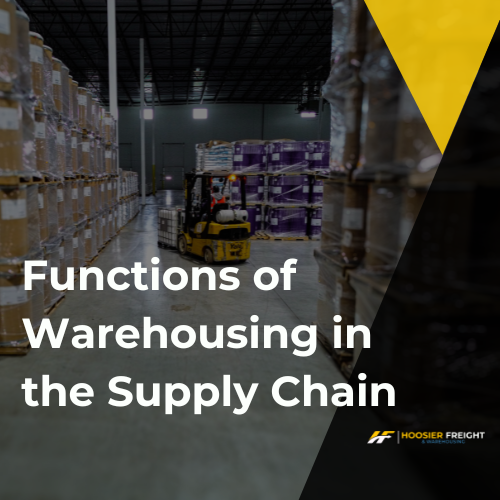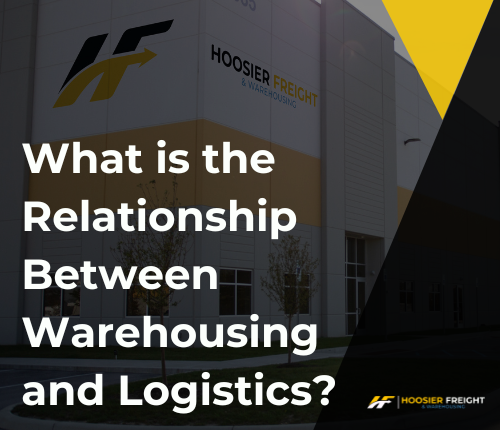
Functions of Warehousing in the Supply Chain
In the sophisticated Freight and Warehousing landscape, the multi-layered function of warehousing plays a crucial role in maintaining supply chain efficiency and meeting market demand. Beyond storage, modern warehouses offer sophisticated inventory management, order fulfillment, and value-added services, making them indispensable in today’s fast-paced market environment.
What is the Definition of Warehousing?
Warehousing encompasses a range of activities beyond mere storage. It involves sophisticated processes for managing inventory, fulfilling orders, and providing value-added services that meet the specific needs of the supply chain. This complexity ensures that products are stored, managed, and dispatched efficiently, maintaining product integrity and timely delivery.
What is the Significance of Warehousing?
The significance of warehousing in ensuring the smooth operation of supply chains is monumental. It provides a crucial buffer that allows for the effective management of supply and demand, facilitating strategies that minimize logistics costs and improve customer service levels.
Warehousing’s strategic value is highlighted in a study by the Logistics Management Institute, which found that effective warehousing could lead to a 25% reduction in overall supply chain costs.
What are the 5 Functions of Warehousing?
- Storage of Goods: Safely storing products until they are needed, minimizing damage and loss.
- Inventory Management: Warehouses employ sophisticated systems to ensure products are available to meet demand without excess surplus.
- Order Fulfillment: From picking to shipping, warehouses ensure orders are processed accurately and efficiently.
- Consolidation and Break-Bulk: Facilitating the efficient distribution of goods by consolidating shipments and breaking down larger shipments into smaller parcels.
- Value-Added Services: Providing services such as packaging and labeling, which enhance the value of the goods stored.
Transport and Warehousing Services Examples
Transport and warehouse services are pivotal in bridging the gap between production and market delivery, offering tailored solutions to meet diverse business needs. For instance, consider a hypothetical scenario where “Global Tech Solutions,” a manufacturer of electronic components, partners with a transport and warehousing company. To manage their delicate inventory and ensure timely delivery to international clients, the warehousing company implements a specialized storage system with climate control and anti-static flooring, coupled with expedited air freight services to minimize transit times.
Another example involves “Fresh Farm Produce,” an agricultural business requiring robust cold chain logistics. The warehousing company offers cold storage facilities to preserve the freshness of produce, integrating RFID tracking for real-time inventory management. Additionally, refrigerated transport services ensure that perishable goods reach retail outlets in optimal condition, following strict delivery schedules to align with market demand.
Lastly, “Crafty Creations,” a small-scale artisanal business, benefits from a warehousing company’s consolidation services, where products from various crafters are stored and assembled into customized gift baskets. This service includes e-commerce fulfillment, with direct shipping to consumers, leveraging the warehouse’s packing and dispatch services to streamline operations and enhance customer satisfaction.
These hypothetical examples illustrate the adaptability of transport and warehouse services in providing customized solutions, ensuring businesses across different sectors can effectively manage their supply chains, from storage to delivery.
Functions of a Warehouse in Logistics
In the modern logistics supply chain, warehouses serve as pivotal nodes, performing a range of functions that extend far beyond simple storage. They are integral components of the logistics network, enhancing efficiency, reducing costs, and improving service delivery across the board. The evolution of warehousing has been marked by the adoption of advanced technologies, data analytics, and automation, transforming these facilities into dynamic centers that significantly boost supply chain performance.
Inventory Management and Optimization: Warehouses play a critical role in managing inventory, utilizing sophisticated Warehouse Management Systems (WMS) to track and control stock levels with precision. For instance, the implementation of WMS can enhance inventory accuracy by up to 99%, as reported by logistics industry analyses. This optimization helps in minimizing holding costs and reducing the risk of stockouts or excess inventory, directly impacting a company’s bottom line.
Order Fulfillment and Distribution: Modern warehouses are at the heart of order fulfillment, processing orders swiftly and accurately. They employ automated picking and packing technologies, which, according to a study in the Journal of Business Logistics, can increase order processing efficiency by up to 40%. This capability ensures that customers receive their products on time, enhancing satisfaction and loyalty.
Value-Added Services: Beyond traditional roles, warehouses now offer a suite of value-added services, including product customization, kitting, and assembly. These services allow businesses to tailor their products closer to the point of delivery, adding significant value. A report from the Supply Chain Management Review highlighted that such services could lead to a 20% increase in customer retention rates by providing a more personalized shopping experience.
Risk Management and Flexibility: Warehouses also serve as critical points for risk management within the supply chain, safeguarding goods against damage, theft, and environmental factors. Furthermore, the flexibility offered by warehousing solutions allows businesses to respond quickly to market changes and demand fluctuations, thereby enhancing supply chain resilience.
In conclusion, the function of warehouses in logistics has evolved significantly, driven by technological advancements and the growing complexity of global supply chains. As noted by logistics experts, the strategic integration of warehousing operations can lead to substantial improvements in supply chain efficiency, cost reduction, and customer satisfaction, underlining the indispensable role of warehouses in modern logistics.
What are the 5 Stages of Warehousing?
The warehousing process encompasses several distinct stages, each playing a critical role in the efficiency and success of warehouse operations:
- Receiving: The critical first step where all incoming goods are checked, documented, and accepted into the warehouse. An efficient receiving process sets the stage for successful inventory management and storage. It includes verifying shipments against purchase orders, inspecting for damage, and accurate logging to ensure inventory systems are updated. The Council of Supply Chain Management Professionals highlights that proper receiving practices can prevent the majority of inventory inaccuracies that plague warehouse operations.
- Put-Away: Following receipt, goods are then moved to their designated storage location. This stage is vital for maintaining organized inventory and facilitating smooth picking processes. Strategic put-away contributes to optimized warehouse space utilization and can reduce operational costs by minimizing the time and effort required for later retrieval. Studies indicate that effective put-away strategies can enhance operational efficiency by up to 25%, according to the Warehouse Education and Research Council.
- Storage: This core function involves holding goods securely until they are required for shipment. Effective storage maximizes warehouse space, protects goods’ integrity, and ensures easy access for picking. Advanced storage solutions, including automated storage and retrieval systems (AS/RS), can significantly increase a warehouse’s capacity and efficiency.
- Picking and Packing: A critical stage in fulfilling customer orders, where items are retrieved (picked) from their storage locations and prepared (packed) for shipping. This labor-intensive process is crucial for order accuracy and customer satisfaction. Implementing technologies like pick-to-light or voice-directed picking can improve picking accuracy and speed, directly impacting customer satisfaction.
- Shipping: The final step involves preparing orders for transport and dispatching them to their destination. This stage requires careful coordination to ensure timely delivery and includes tasks such as scheduling shipments, loading goods, and documenting departure. Efficient shipping practices are essential for meeting delivery commitments and maintaining high levels of customer service.
What are 3 Benefits of Warehousing?
Warehousing offers numerous advantages that significantly impact supply chain performance:
- Supply Chain Efficiency: Warehouses play a central role in ensuring the smooth flow of goods through the supply chain. By enabling effective inventory management and reducing lead times, warehouses contribute to overall supply chain efficiency. For example, a study by the International Warehouse Logistics Association showed that strategic warehouse locations could reduce total logistics costs by up to 15%.
- Cost Savings: Through optimized storage solutions and efficient inventory management, warehousing can lead to substantial cost savings. Bulk storage and the ability to manage stock levels effectively allow businesses to minimize holding costs and avoid stockouts or excess inventory. The American Logistics Aid Network reports that well-managed warehouses can reduce storage costs by an average of 20%.
- Enhanced Service Levels: By facilitating rapid order fulfillment and minimizing delivery times, warehousing services significantly enhance customer service levels. Warehouses equipped with advanced management systems can quickly process orders, ensuring products are delivered to customers promptly and accurately. This responsiveness is key to building customer loyalty and competitiveness in the market.
Warehousing’s role within the supply chain is undeniably crucial, offering a broad spectrum of functions that enhance efficiency, reduce costs, and improve service delivery. From strategic inventory management to sophisticated order fulfillment operations, warehouses are key to facilitating the seamless flow of goods through the supply chain, ultimately contributing to business success and customer satisfaction.
Elevate your supply chain efficiency with Hoosier Freight and Warehousing. Our state-of-the-art warehousing solutions are tailored to optimize your logistics operations, ensuring your products are stored, managed, and delivered with precision. Contact us today to discover how our warehousing services can transform your supply chain management.



